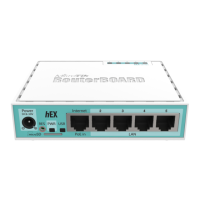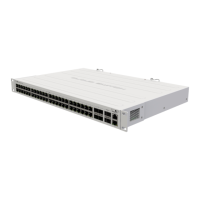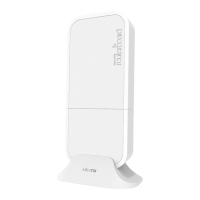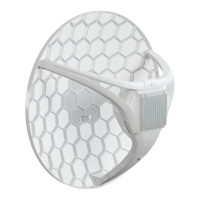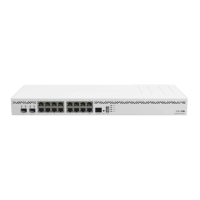RouterBOARD 450/G Series User's Manual
RouterBOOT booter 2.9
RouterBoard 450
CPU frequency: 680 MHz
Memory size: 256 MB
Press any key within 2 seconds to enter setup
RouterBOOT-2.9
What do you want to configure?
d - boot delay
k - boot key
s - serial console
o - boot device
f - cpu frequency
r - reset configuration
e - format nand
g - upgrade firmware
i - board info
p - boot protocol
t - do memory testing
x - exit setup
your choice:
To select a menu point, press the key written at the beginning of this line. Pressing [Enter] selects the option
marked with '*'.
Configurable Options
boot delay – how much time to wait for a key stroke while booting (1..9 seconds; 2 second by default).
boot key – which key will cause the loader to enter configuration mode during boot delay (any key |
<Delete> key only; any key by default). Note that in some serial terminal programs, it is impossible to use
the [Delete] key to enter the setup – in this case it might be possible to do this with the [Backspace] key.
serial console – to configure initial serial console bitrate (1200 | 2400 | 4800 | 9600 | 19200 | 38400 |
57600 | 115200; 115200 bps by default).
cpu-frequency – CPU frequency (680MHz and 800MHz. 680MHz default, 800MHz – overclock. use with
caution).
boot device – initial boot device (boot over Ethernet | boot from NAND | boot Ethernet once, then NAND;
boot from NAND by default). You can also select boot chosen device option to boot from the device
selected immediately, without saving the setting.
reset configuration – whether to reset all the boot loader settings to their respective default values (yes |
no; no by default).
format nand – perform a low-level NAND format. During this operation, all previously marked bad sectors
are retested to find out if they are faulty indeed.
upgrade firmware – receive a new boot loader image using XModem protocol over serial line or using
DHCP/BOOTP and TFTP protocols through the Ethernet network (upgrade firmware over ethernet | upgrade
firmware over serial port).
board info – prints the serial number, boot loader version, CPU frequency, memory size and MAC addresses
of the onboard Ethernet ports
boot protocol – network booting protocol (bootp protocol | dhcp protocol; bootp protocol by default).
do memory testing – performs a full memory test.
Boot Loader Upgrading
The boot loader is needed to initialize all the hardware and boot the system up. Newer loader versions might
have support for more hardware, so it's generally a good idea to upgrade the loader once a newer version is
available. You can upgrade the loader through the onboard serial port using XModem protocol (programs
available for all major OSs). For example, you can use HyperTerminal for Windows or Minicom for Linux to
upload the boot loader. Alternatively if you have a DHCP/BOOTP and TFTP servers available, you can specify
7

